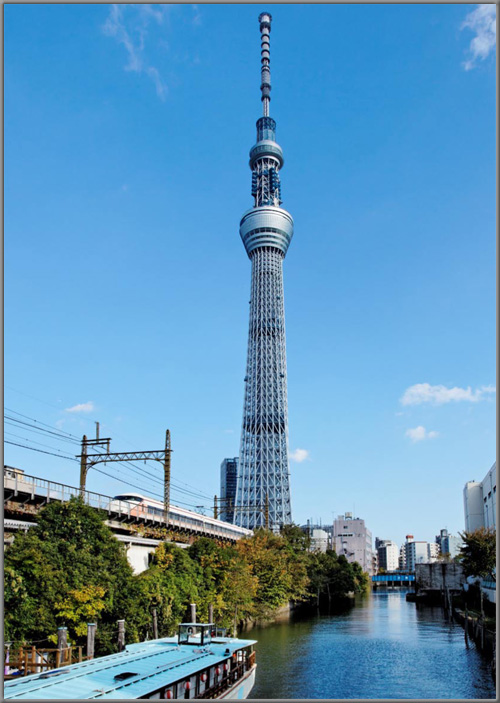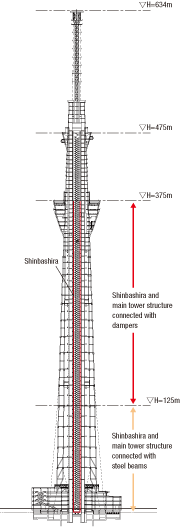Home > Highlighting JAPAN > Highlighting Japan DECEMBER 2011 > Pillars of Strength
Highlighting JAPAN
COVER STORY: Pillars of Strength
Caption: Standing 634 meters tall, Tokyo Sky Tree was officially recognized
by Guinness World Records in November as the world's tallest tower.
Pillars of Strength

Structure of Tokyo Sky Tree
On March 11, Tokyo Sky Tree, which is under construction in Sumida Ward in Tokyo, was shaken by the Great East Japan Earthquake. The peak section, with a height of over 600 meters, is estimated to have moved 4 to 6 meters sideways. However, Tokyo Sky Tree was not damaged in the earthquake.
One of the reasons why Tokyo Sky Tree withstood the enormous quake was the vibration suppression system, used for the first time ever, known as Shinbashira-seishin (Center Column Vibration Control). The core section of the main structure of Tokyo Sky Tree is a void measuring 10 meters in diameter, which extends up to a height of about 475 meters. A cylindrical column made of reinforced concrete measuring 8 meters in diameter and 375 meters in height, called the shinbashira (center column), has been installed through the void as if piercing Tokyo Sky Tree. Even though the shinbashira is structurally separated from the main tower structure, the two are joined by steel beams up to a height of 125 meters, and via devices called dampers that suppress vibrations by stretching and contracting in the sections above. The shinbashira is heavier than the main tower structure, which is made of steel, and barely vibrates. As such, the shinbashira and the main tower structure behave differently when shaken by an earthquake or storm. If the two move in opposite directions, the vibration is canceled. It is said that the Shinbashira-seishin system reduces seismic vibration by up to about 50%.
"Shinbashira" is the term signifying the column built at the core of traditional five-storied pagodas in Japan. There have been almost no reports of collapses of five-storied pagodas, of which the one at the World Heritage Site Horyu-ji temple in Ikaruga-cho, Nara Prefecture is a typical example. According to Nikken Sekkei, the company that designed Tokyo Sky Tree, a structure similar to that of the traditional five-storied pagodas resulted when they studied the latest vibration suppression systems. This was why they decided to use the name "shinbashira."
© 2009 Cabinet Office, Government of Japan






